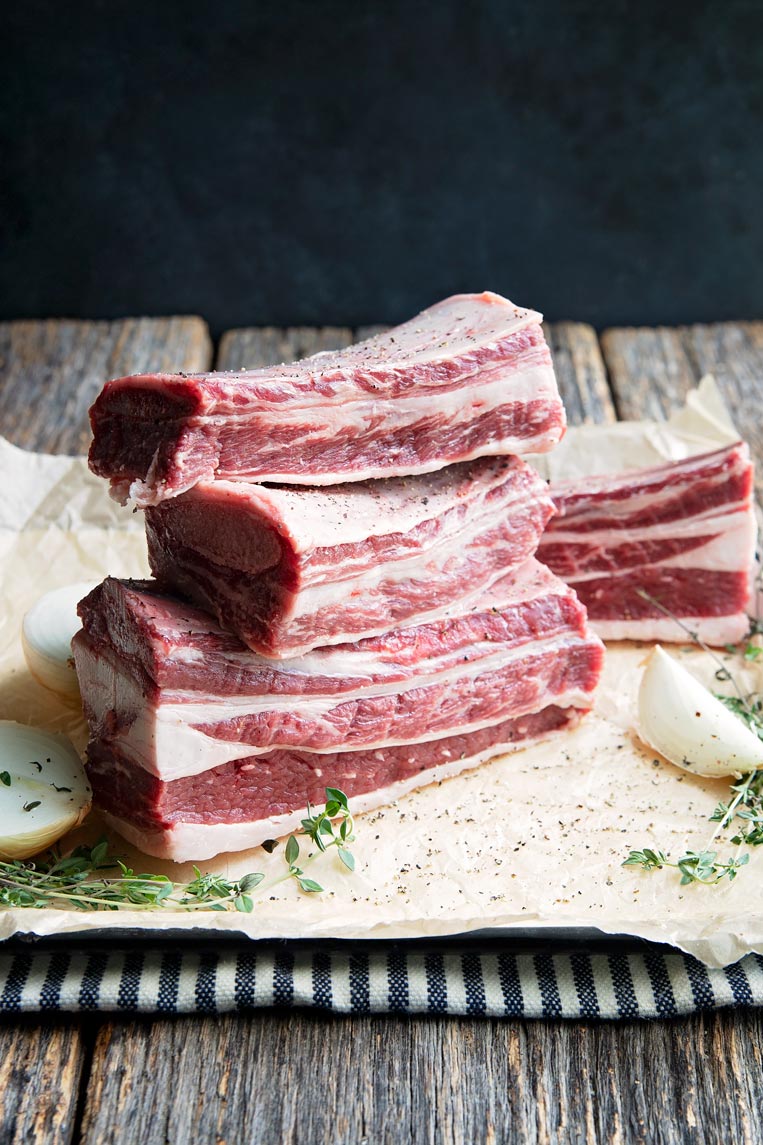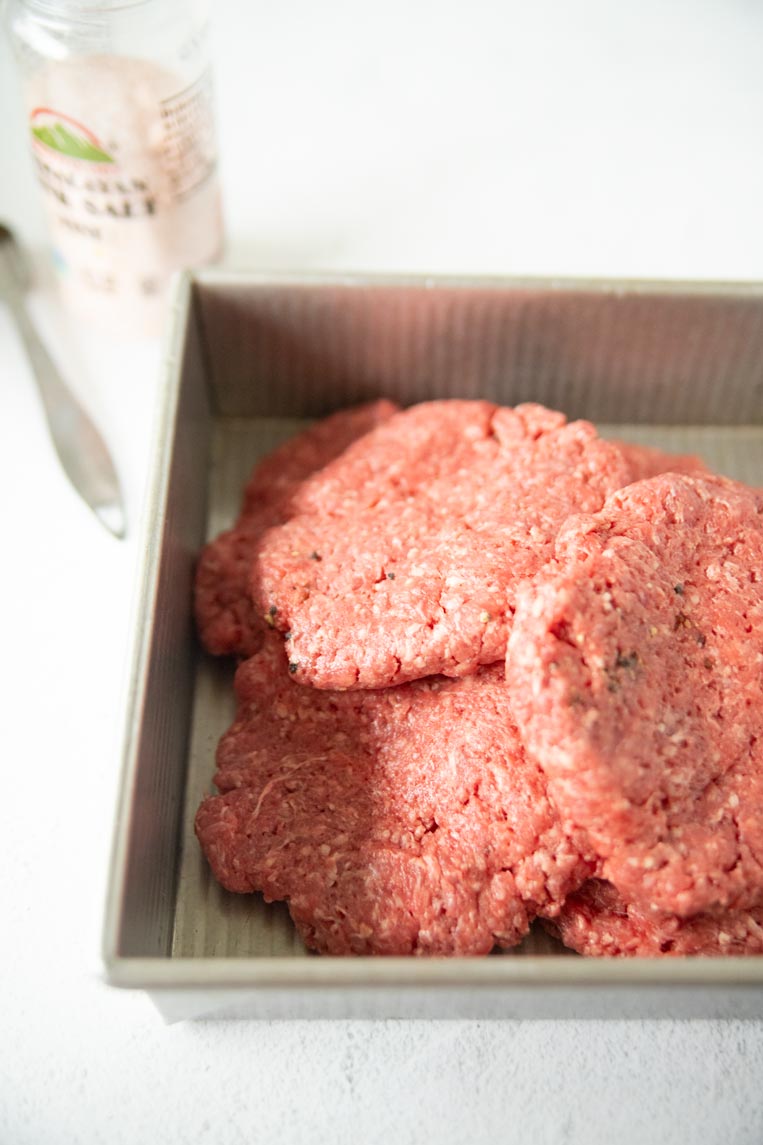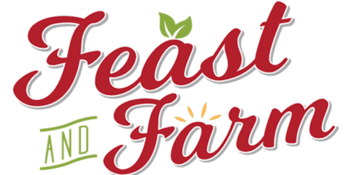Grass fed beef vs grain fed: Your unbiased guide
Grass fed beef vs grain fed: Which one tastes better and is better for you? Cut through the hype and get your information straight from an unbiased source. As a life-long beef farmer and someone who also cares about what’s good for you–I’ll give it to you without any biased slant.

What does “grass fed” or “grain fed” really mean?
First, know that the majority of a cow’s diet is grass and hay. For cows who are grain fed, it’s only 10% of a cow’s total diet during their lifetime–the rest is still grass. In warm weather cows eat pasture and in cold weather months cows are fed hay (which is dried grass if you didn’t know).
Cows that are grass fed only eat hay or pasture throughout their life and are termed “grass fed”.
Cows that eat grass and also are fed grain either to supplement their hay and pasture allotment or closer to the end of their life before slaughter are termed “grain fed”.
However these terms only refer to a cow’s diet and not much about its lifestyle. They tell you nothing about if that cow was in a pen and fed exclusively grass/hay. It doesn’t tell you if that cow was raised by organic or certified naturally grown standards. It doesn’t tell you if it was healthy at the time of slaughter.
Grass fed beef vs. grain fed also doesn’t tell you if that cow has had antibiotics or growth hormones during its life if that matters to you.
Remember: The terms grass fed or grain fed tell you nothing about how that cow was raised or its health at slaughter.
Why does everyone promote grass fed beef?
Because it’s trendy and many people do believe it’s healthier–but there’s always a catch or two. From a macros and nutritional standpoint, grass fed and grain fed beef are strikingly similar. According to the National Beef Checkoff–a source for beef information that’s non biased–here are the nutritional statistics for grass fed beef vs. grain fed:
Grass Fed
Protein: 21.8
Zinc: 3.7
Iron: 1.8
Total fat: 2.9
Grain Fed
Protein: 22
Zinc: 3.8
Iron: 1.6
Total fat: 5.2
Fat amounts on grain fed beef will be higher because grain fed cows have more marbling or fat throughout the meat. You can see that both grass and grain fed are very similar in protein, zinc and iron levels and beef from either source contains more than 10 different essential nutrients. There’s not the big difference in nutrition everyone would want you to believe.
The omega 3 vs 6 debate: Why some say grain fed is unhealthy
So here’s where the debate comes in. Americans as a whole eat way too many omega-6 fatty acids. Say a big thank you to vegetable oil and processed food for that one. Everyone wants to blame the beef for it when no one is looking at the amount of seed oils (canola, vegetable, safflower and sunflower) and fast food that’s fried in it that we’re eating in this country.
Eating omega-6’s in moderation may not be an issue as long as they are outweighed by the inflammatory-fighting healthy benefits of omega-3 fatty acids. Your diet should be predominantly omega-3 fats like those from fish, avocados, and nuts and seeds.
Not surprisingly, cattle that are grain fed are higher in omega-6 fats mostly because the grain sources they are fed like corn and soybeans are naturally high in those fats. So people like to say that grain fed beef is unhealthy because of its omega-6 ratios. Grain fed beef has a ratio of omega 6 to omega 3 of 9:1. Grass fed has a ratio of 2:1. So there are 9 times more omega-6 fats in grain fed compared to just 2 times as many in grass fed.
I don’t think this is an issue if you aren’t eating beef three times a day at every meal.

GMO’s, Glyphosate and Chemicals
Unless your grain fed beef is organic or your farmer is very picky, then it’s probable that the grains fed to these cattle have some GMO’s in them. GMO crops like field corn and soybeans are used to make grain feeds for cattle.
GMO’s or genetically modified organisms are plants that have had their genetic structure changed to live even after being sprayed with glyphosate (a toxic weed killer). It kills the grass and weeds around them, but not the crops.
These traces of glyphosate end up being eaten by the animal in their feed, and then eaten by you.
It’s worth noting that glyphosate is in everything these days. Even organic foods have traces of it because it has so permeated our farmlands.
If GMO’s matter to you, make sure you beef is not just grass fed, but also organic. Organic farming practices prohibit the use of GMO’s and glyphosate.
How does grass fed beef vs grain fed beef taste?
Anyone who has grown up eating local beef knows the answer to this. Grass fed beef usually tastes bland, and feels dry and tough because it’s so much lower in fat. It’s easy to over cook it. Fat is flavor and when that’s taken away, the flavor of the beef really suffers.
Grain fed beef has more fat and that fat adds juiciness and flavor. It’s not a gamey taste–just richer than grass fed and I think it’s sweeter.
Most beef farmers I know prefer to eat grain fed beef, but we won’t pass up a grass fed burger if it’s offered. I can assure you that I can tell you what kind of beef I’m eating after just one taste.
What matters more when it comes to buying beef
I think what matters more is the life of the cow. How it was raised (including what it was fed) and what medications it took. Did that cow live on green pastures with fresh water and a place to graze? Was it healthy at slaughter or had it been sick lately? Your store bought beef will never be able to answer those questions.
Cows on our farm only get antibiotics if they are sick–just like you do–and those cases are very rare. I think it’s been over 6 years since our main herd cattle needed any medication. Their calves (the only cattle we sell to market) 99% of the time never take any antibiotics. I don’t know any farmers who give their cows medications “just in case” or on any kind of daily basis. We don’t medicate their feed. Our cows are corn-fed and we have no problem with that.
When you source your beef, get it local, and get it from a farmer so you can ask questions. Find out about the cow’s life and get one that’s strong, has shiny fur, looks healthy and is out on pasture.
So where does beef at the grocery store come from?
It can come from a few places. In 2020, for every pound of US beef this country exported, we imported 1.5 pounds. And that’s just the meat itself we were tracking. The number of imported cattle is even higher and the beef is coming from Canada, Australia and much of Mexico and Latin America.
Once the meat passes inspection here in the United States, it gets a “product of the USA” label even if it wasn’t raised here. At the time of this article’s creation, the USDA was looking at possibly changing this loophole.
US raised beef is largely produced on farms just like mine all over the country then those cattle are sold and shipped out West to a feedlot facility where they are grain fed a scientifically balanced diet for a specific time before going to one of the big 4 meat processors in the United States. These 4 companies process, control and ship 85% of all beef in the United States.
And that’s the meat you find in your grocery store. Processed and packed in black plastic containers in long strings you never can seem to break up when it cooks. You don’t know where it came from and next to nothing about its life.
That’s your grain fed supermarket meat.

Our personal story with grain fed beef
Life is all about balance and eating too much of any one food can be unhealthy in the end. We don’t eat beef exclusively (that would be crazy) but we do eat it 3 to 4 times a week at our house as part of our commitment to eating real, whole foods. We eat grain fed, but it’s locally sourced.
When I was stricken with a paralyzing autoimmune disease in 2019 and sentenced to a wheelchair, I began a strict regimen to rehab my body with food as my medicine. Beef was a big part of my plan due to its amazing nutritional content. I’m proud to say I’m out of my wheelchair and thriving and a good burger (off the bun) is a regular meal for me.
My husband lowered (yes, I said lowered) his cholesterol 32 points on a diet of red meat, butter and eggs. He’s also lost more than 25 pounds on the same diet. We took out processed food, sugar, and refined oils instead. Amazing!
Want what a beef farmer wants, and its this
A healthy cow.
A locally raised cow.
A cow that was healthy when it was slaughtered.
A cow that enjoyed green pasture and clean water.
Maybe (big maybe) an organic cow.
Better food is a journey. Do what you can, then do better. Don’t let anyone make you feel bad for whatever choice you make and can afford.
Sources for grass fed and grain fed beef
There are so many amazing places to get great beef these days!
- Start by looking for local meat processors near you. Call them and ask them if they have anyone who provides beef to them and then call those farmers and ask questions. We source our beef from a local Amish slaughter house and it’s just wonderful. If you’re in Kentucky, Showalter’s is your go-to.
- Websites like Eat Wild may connect you with a farmer in your area who will deliver your cow to the processor of your choice.
- Porter Road is a Tennessee based butcher shop committed to great meat. It’s “pasture raised” but there are no details about grain. You can ask them but based on the delicious taste, I feel sure it’s grain fed.
- We ordered Moink Beef for years and years and loved it. I really liked that they can tell you exactly which small farm your beef came from and it helps family farms.
- Butcher Box is also super popular. I’ve never tried it, but lots of people like it.
**I fully expect this to be a very polarizing topic. Please keep your comments civil. Thanks!








I tried my neighbour’s grass fed beef once, and found it to be tough and very gamey. Yet, I love venison. And I love grain fed beef.
Team grain fed over here too Char. 🙂
Checking out your website looking for info about “only” grain fed cows in a inside/outside cement floor paddock. Didn’t sound good to me. Would love your opinion.
Hey Lisa, great question. What you are describing is a feed lot situation. I’m sure those cows are getting hay. No cow survives on just grain and grain is a tiny part of a cow’s total diet anyway. Nutritionally, the data isn’t a lot different for grain fed vs. grass fed cows except for those Omega 3’s and 6’s ratios and the fact that you don’t know what’s in those grains as far as GMO’s and such. Cows were meant to live in pastures and remain there until slaughter. I prefer cattle raised locally on fresh grass and clean water, lounging in the sun but fed on grains. I guess I’m a bit of a blend of things.
It isn’t just grass fed, proper grazing and field rotation allow for soil improvement this in turn improves yield per acre. The mono crop farming practices for corn and soy are destructive and severely deplete the soil. Ruminants are the natural intent for soil health and proper management leads to improvements in all aspects of the life cycle.
Thank you for this article!!! I’m now on the list for our first half cow from Hillis Processing in Sparta, TN. I started the journey of considering a half cow mainly because of skyrocketing beef prices and limited supply of cuts we enjoy. But, I’m also the person who prefers to buy as much as possible made in the USA and our food locally grown. I debated on grass fed but settled with grain and Hillis since they do not use hormones, pesticides or vaccines. I will also be able to have them mix in some of the organs in the ground. The meat we’ll receive will be near prime quality :).
Great to hear Delta!
Thanks for your producer’s perspective. From an environmental point of view, grass-fed is worse because it needs more land, and that’s worse for everything – carbon, biodiversity and I think, business. Especially as farmers start to get paid (rightly!) for producing carbon and biodiversity. I work on this problem as an academic for the Australian meat industry’s C neutral target. The misconceptions about land inefficient practices such as grass feeding and organics frustrate me! If you give cows the choice they wouldn’t live off grass. You just try keeping those ‘free’ grass-fed cows out of paddocks offering a choice!
Grains used to feed the cows are often genetically modified grains. There are literally countless stories of people unable to get their health under control by eating grain-fed meat. As soon as they switch to grass-fed, they have less issues with digestion and their health begins to get better. You have to also watch glyphosates in grass-fed animals. You MUST visit the farm before buying your meat. If they claim to be grass-fed, and yet the animals are grazing on grass that has been sprayed with glyphosates, then you are literally poisoning your body.
Also, Pasture-fed cows or feedlot cattle not yet adapted to grain may become acutely ill or die after eating only moderate amounts of grain. Their stomachs have a very hard time digesting these poisonous grains.
I’ve seen serious health benefits from eating grass-fed, grass-finished meat. As soon as I switch to grain-fed meat, my digestion gets really bad. I see the positives of grass-fed meat.
Thank you for your feedback and personal experience Kevin.
One thing we want to remember is that glyphosate is a non selective herbicide. Cattle won’t be grazing on grasses sprayed with it because #1) the grass would all be dead and #2) It’s used primarily on grains like oats, soybeans and wheat. Cows don’t eat wheat and the GMO crops that are sprayed with it ends up in their grain rations.
It is possible though that cattle could graze on land where glyphosate has been used in the past and remains in the soil, or on grasses with synthetic fertilizer and other herbicides, pesticides and fungicides. There’s never going to be a way to eliminate ALL glyphosate from our diets because it’s permeated everything but being aware of what you’re eating is always the best priority. –Rachel
Sir it sounds like you have a problem digesting meat fats. Those are hard for some people to digest. It is not because of the grain unless someone has acute allergies to a certain grain. As a farmer who deals with this on a daily basis and provides meat directly to the consumer, I can vouch for the fact that some people who have gluten issues will fair better with grass fed beef. Sometimes we have to look beyond what we see on the surface into the actual causes of problems such as digestion.
Secondly, I am in complete agreement that one should visit the farm where they source their beef and learn about the process. I would like to correct a couple of things that you mentioned however from an experienced farmers standpoint.
First I have never seen a cow which is offered both pasture/hay and grain get sick or slow their eating at all when they transition onto a grain based diet. We offer as much pasture grass/hay and grain as the cattle would like to eat. The cattle choose which one they eat and how much. Cattle like all animals have a sense and a taste for the nutrition that their body is in need of. Calf’s can transition straight off a mothers milk onto grain with grass/hay available also.
Second, I have never heard of a farmer spraying glyphosate on a pasture unless they were wanting to destroy it. If we did spray our pasture grass with glyphosate then all of our pasture grass would be dead, as grass is killed easier than most plants by glyphosate. This is across the board in the beef industry as no one has pastures that can be sprayed with glyphosate as the grass would not live.
This post is not to cause and argument, but to educate the public from someone who makes a living providing beef. It is also to correct the vast amount of misinformation on the internet and in media about cattle nutrition and the beef that you eat. I could make more money selling grass fed, because of the current market conditions, but I personally do not like the taste and believe that there is absolutely nothing wrong with a grain finished cow that has the pasture/hay as an option also. My children eat the meat that we grow and I am confident that it is wholesome and healthy. I hope that this has provided you and others food for thought on some of these issues, and while I could not address everything in one post, don’t always believe everything you are told. As you said yourself, go to your local farm and see for yourself. Talk to the one who is growing it.
Backing you up on this John!
I am so grateful to have come across your article; it answers all of the questions that I’ve been wondering about for a while now. Oddly, I too have a severe autoimmune disorder, two actually, and have changed my diet several times in Ann get to at least try and find out if there is any impact from the changes. So far the only real change has comes from not eating processed food! I’m going to find a local farm and do just what you suggested, perhaps even visit, the farm, to see what the life of that core is like. Then I’m going to have a hamburger and see here I feel lol
Truly, thank you!
Donna I’m so glad you found this helpful! I really wanted to present the facts and let you choose what works for you. And yes–have a hamburger! Hahahaha! –Rachel
Great article. I have tried explaining this to people for years.
People are always talking about taking red meat out of their diet without looking at all the other factors. It’s unbelievable to me that people still eat these disgusting oils and blame the meat that they’re eating! I agree 100% with everything that you said. I also have an auto immune disease that, by now, should have me in some sort of end-stage liver disease. Because of the way I eat I am still at stage zero – 15 years later!
I use US Wellness for my meat & bones.
That’s a wonderful testimony to how good meat is for us Lucy! And yes–there’s a lot of blame put on things that aren’t really the problem while no one notices the food that is! We know better though so let’s try and spread the word. 🙂 –Rachel
Thank you! Good point that even though labeled grass-fed in the grocery store we have no real idea of its condition before slaughter. We are organic farmers, and a healthy cow is very important to us.
I’m glad you can back me up on that Laurel! –Rachel